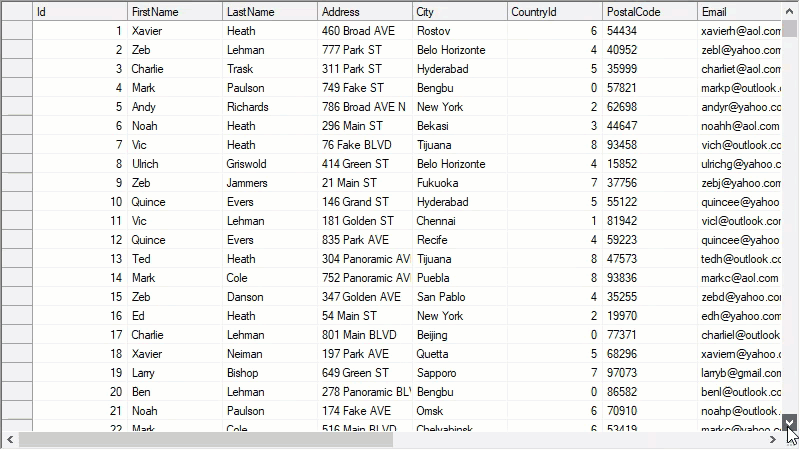Data Virtualization
Data virtualization refers to the process of loading data from remote sources in incremental manner, instead of loading it all at once. That is, in virtual mode, data is loaded on demand in chunks as the user scrolls the grid. Hence, the process is really useful while dealing with huge volumes of data and enables efficient loading of data in a shorter period of time.
There are two widely adopted approaches for data virtualization, pagination and cursor. In Pagination approach, a limit and offset parameter are send to the remote source to specify which portion of the data is requested. This approach returns the total amount of items available, so that the client may know how to retrieve the rest of the items. While, in Cursor approach, a token is send initially, which is null at first, to fetch the pages sequentially. In this case, the received page contains the token to the next one.

FlexGrid supports data virtualization and gives excellent performance while loading large data sets in real time. To implement virtual mode in the FlexGrid control, we use C1DataCollection library which provides data virtualization for any datagrid or list control.
The C1DataCollection namespace provides C1VirtualDataCollection and C1CursorDataCollection to implement pagination and cursor approach respectively. Both classes have an abstract GetPageAsync() method that must be implemented to return the items that will populate the collection. The base classes take the responsibility of caching the data as well as dispatching the requests of the pages according to a series of parameters that prevents too many pages to be requested together. In this topic, we are explaining the data virtualization and its implementation using the C1VirtualDataCollection class.
Implement Data Virtualization
First of all, implement the C1VirtualDataCollection interface to override the GetPageAsync method as per your data. The GetPageAsync method of C1VirtualDataCollection returns the items in the page as well as a token to the next page. This method uses pageIndex, startingIndex, count, sortDescriptions, filterExpression and cancellation Token as parameters. The parameters pageIndex denotes the index of the requesting page, startingIndex denotes the index where the returned items will be inserted and count denotes the number of items to be returned. The GetPageAsync method returns total number of items (TotalCount) along with a list of the requested number of items (count) starting from an index (startingIndex).
public class VirtualModeCollectionView : C1VirtualDataCollection<Customer>
{
public int TotalCount { get; set; } = 1_000;
protected override async Task<Tuple<int, IReadOnlyList<Customer>>> GetPageAsync(int pageIndex, int startingIndex, int count, IReadOnlyList<SortDescription> sortDescriptions = null, FilterExpression filterExpression = null, CancellationToken cancellationToken = default(CancellationToken))
{
await Task.Delay(500, cancellationToken);//Simulates network traffic.
return new Tuple<int, IReadOnlyList<Customer>>(TotalCount, Enumerable.Range(startingIndex, count).Select(i => new Customer(i)).ToList());
}
}Public Class VirtualModeCollectionView
Inherits C1VirtualDataCollection(Of Customer)
Public Property TotalCount As Integer = 1_000
Protected Overrides Async Function GetPageAsync(ByVal pageIndex As Integer, ByVal startingIndex As Integer, ByVal count As Integer, ByVal Optional sortDescriptions As IReadOnlyList(Of SortDescription) = Nothing, ByVal Optional filterExpression As FilterExpression = Nothing, ByVal Optional cancellationToken As CancellationToken = Nothing) As Task(Of Tuple(Of Integer, IReadOnlyList(Of Customer)))
Await Task.Delay(500, cancellationToken)
Return New Tuple(Of Integer, IReadOnlyList(Of Customer))(TotalCount, Enumerable.Range(startingIndex, count).[Select](Function(i) New Customer(i)).ToList())
End Function
End ClassApply Data Virtualization to FlexGrid
To apply data virtualization on FlexGrid and populate it with the virtual data collection, create an object of C1DataCollectionBindingList passing an instance of VirtualModeCollectionView and assign it to DataSource property of the grid.
private void Form1_Load(object sender, EventArgs e)
{
var collectionView = new VirtualModeCollectionView();
c1FlexGrid1.DataSource = new C1DataCollectionBindingList(collectionView);
c1FlexGrid1.Visible = true;
}Private Sub Form1_Load(sender As Object, e As EventArgs) Handles MyBase.Load
Dim collectionView As New VirtualModeCollectionView
Dim data = New C1DataCollectionBindingList(collectionView)
C1FlexGrid1.DataSource = New C1DataCollectionBindingList(collectionView)
C1FlexGrid1.Visible = True
End Sub

